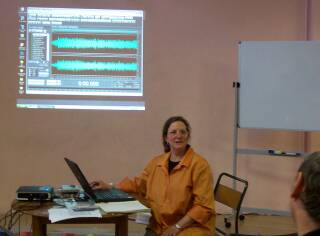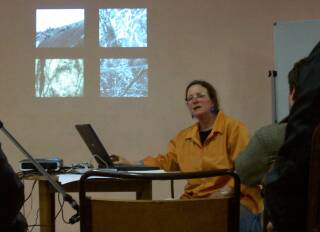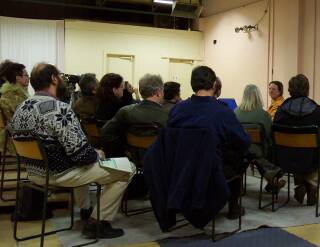


Catherine Schieve - Moving between the eye and the ear
reviewed by John Jenkins
Catherine Schieve presented a live performance as part of her presentation, which also included a rich variety of visual material – reflecting her unique approach to composition.It is not surprising that composers should have vivid aural imaginations – the ability to 'picture' and 'feel' sounds. But one of the remarkable things about Schieve's work is the central role of the other 'sensory modalities', and how she strives to enlist them in a total artistic synthesis. She is as much a visual artist as a composer of sounds. Indeed, sound and image are so closely aligned for her that one can be translated into the other. Her acute kinaesthetic imagination – similar to that of dancers, who have an intuitive-somatic apprehension of the fluid movement of the human body through space – also plays a central role. Remaining true to a more complete sensory picture of the world, in order to realise her works, has also prompted Schieve to devise novel systems of musical scoring, or visual notation.
Schieve's talk began with a literal sketch of her artistic world – a graphic composed into about 20 'fields', all under various headings, such as 'found lines', 'field recording', 'performance videos', 'graphic scores', 'objects of contemplation' and so on. Her talk moved and meandered around these topics, but not in any categorical or linear way. It was also notable that she gave no dates for pieces, because she says the concerns in her work have been abiding ones – embryonic, at least, from the very start. These preoccupations might emerge or recede, to a greater or lesser degree, in any particular work, and so the idea of her career as a linear progression is one she wished to avoid.
Enchanted Rock, was a "a dance with video" inspired by landscapes of central Texas. The composer moved across the highly textured rocky terrain with hand-held camera, swooping over the moonscape-from-space-like surfaces, outcrops, crazed seams and ledges, all reflecting light or collecting shadows. It was important for Schieve to "never stand still…to always move…I am not interested in the frame or framing….I want to move around 360 degrees of space, using the camera to sweep across everything, like a paintbrush".
Often, Schieve likes her 'field recordings' to be low-tech, such as Giving Flowers to the Sea Goddess, which evolved from written notes, pencil drawings and some still photographs.
Another part of Schieve's work is her 'found lines' pieces - in which she collects chance-made lines, such as chalk marks on footpaths, cracks in lava flows, trails left on the sand by tiny molluscs, and so on. These become material for graphic scores. Performance activities have also resulted in "residual lines," -- floor drawings or even room-size installations of drawn line, branches and shadows. These are photographed as momentary pieces, then the materials are recycled into further visual and performance works.
Schieve is careful to point out, however, that realisation of her graphic scores is never slap-dash or haphazard. Although there is often an element of improvisation, and certainly of interpretation, works are strongly composed, and the way they are played conducted and directed. For example, in Labyrinth, a 12-tone piece, a group of players meander through the score in set ways, with the sounds "coalescing into clouds". The piece is composed and conducted in a global sense, through allowing free interpretation on "the microscopic level of detail". Similarly, in Tiger's Eye, a 'line piece' for clarinets, smaller parts fit together as sections of a continuous line.
Ink Jungle takes her line pieces to a larger scale and greater level of complexity. Designed for two or more performers, perhaps as many as six, the score for this piece is a large painting, which evolved out of a smaller 'random line drawing'. Schieve then took slides of the drawing at various degrees of magnification and, using multiple projections, re-enacted the creation of the drawing on a large scale to create the vertically hanging semi-transparent score. Performers rapidly 'throw ' vocal and airy instrumental sounds through the score from both sides, as if creating a sonic hologram in the air.
These graphic scores could be read from left to right, right to left, up to down, and vice versa. Schieve says: "Orchestrating the eye movements of players then became important – as did invented instruments, to deal with all of this. I want to leave the pitch/time grid behind… I didn't want a pitch continuum divided into discrete steps."
Web evolved from a line drawing remade as a 2 x 3 metre painting placed on the performance space floor. The lines were conceived for sliding instruments, while intersections between the ends of lines were superimposed onto the original painting as coloured dots and smaller lines. In this way, the painting generated new 'parts'' for various clicking instruments. The performers spiralled around and across the painting, and it took 30 minutes for them to 'play' every gesture in the entire canvass.
In collaboration with the composer Warren Burt, Schieve has experimented with a 'Free Music Machine'', modelled on a prototype by Percy Grainger and redesigned by Burt, using inbuilt light-sensors able to translate visual elements (colours and shapes) into sounds. Rolls of transparant plastic inscribed with visual shapes flow through the machine, akin to punched paper through a player piano. The score for Aviary uses titanium white designs embedded in translucent paper, all fused into the plastic surface to influence the oscillators' pitch and volume. The making of the score itself was a sonic event as the brush crossed light sensors, and the resulting twittering became the backing track for the piece.
Blue Line is a recent large-scale piece capable of multiple realisations. The score, which doubles as a visual component of the piece, is a strip of translucent canvas more than 100 feet in length. Painted in tones of blue, it is river-like in quality and can be stretched through a forest, across snow landscapes or alongside a busy urban road. Conceived for choir, electronics and a series of "circulating instruments", a full-scale realisation of this piece is presently being planned.
Finally, Water is a video projection of sea images – some treated and digitised. Water textures, wave lines and dancing light-stars are synchronised to a soundtrack of sampled water sounds, plus ritualistic chanting, vocal sounds and fragments of "found music" from Northern India and other locations. In addition, two live players both play thin aluminium plates suspended between sausage-shaped balloons, struck with xylophone hammers. This piece was realised by Warren Burt and the composer.
